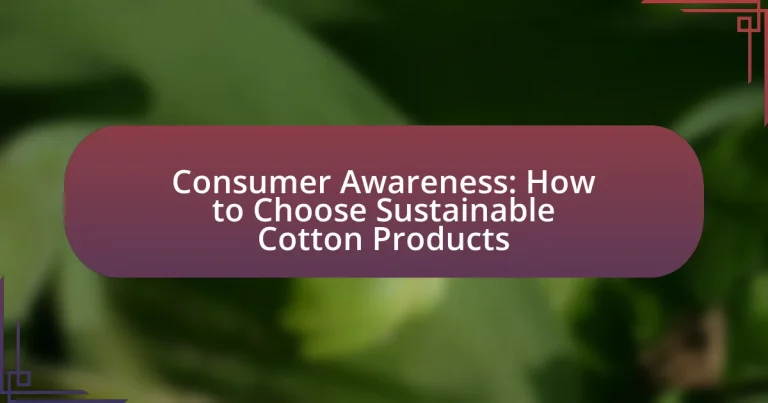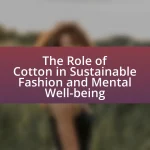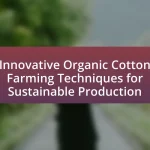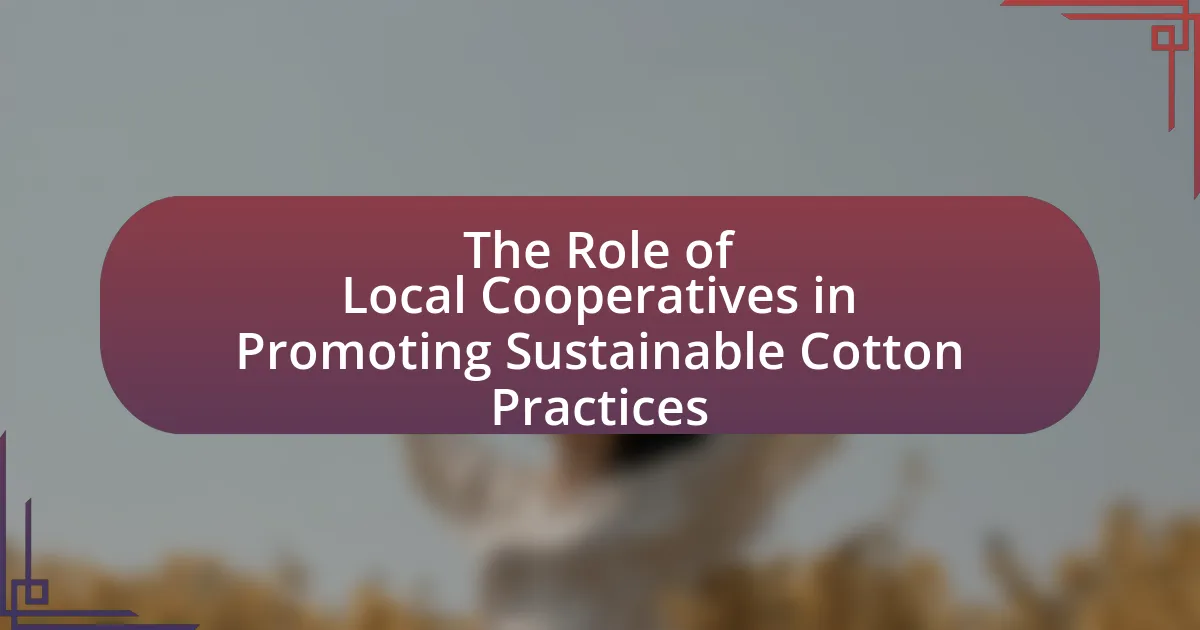Consumer awareness regarding sustainable cotton products encompasses the understanding of the environmental and social impacts associated with cotton production. This awareness is vital as it influences purchasing decisions, encouraging consumers to opt for products that adhere to sustainable practices, such as organic farming and fair labor conditions. The article outlines the importance of consumer education in identifying sustainable cotton, the characteristics that distinguish sustainable cotton from conventional options, and the certifications that consumers should look for. Additionally, it addresses the challenges consumers face, including greenwashing and misconceptions about sustainable cotton, while providing practical steps for making informed choices and advocating for sustainable practices in the cotton industry.
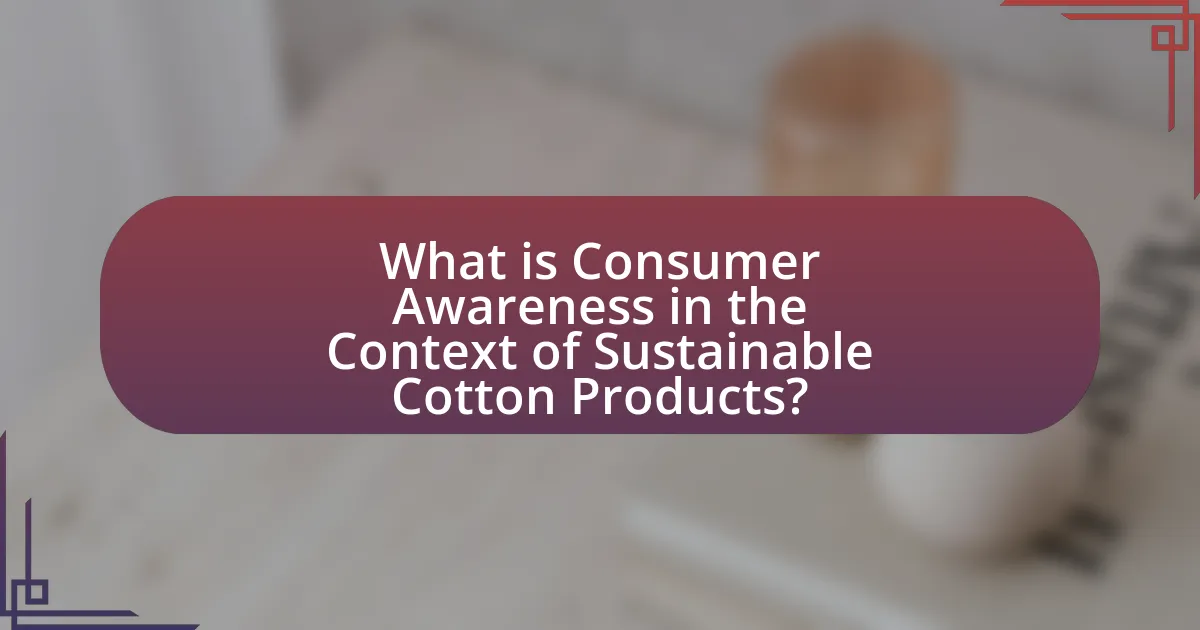
What is Consumer Awareness in the Context of Sustainable Cotton Products?
Consumer awareness in the context of sustainable cotton products refers to the understanding and knowledge that consumers possess regarding the environmental and social impacts of cotton production. This awareness enables consumers to make informed choices about purchasing cotton products that are produced sustainably, which includes considerations such as organic farming practices, fair labor conditions, and reduced chemical usage. Research indicates that consumers who are aware of these factors are more likely to support brands that prioritize sustainability, thereby influencing market trends and encouraging manufacturers to adopt eco-friendly practices.
Why is consumer awareness important for sustainable cotton products?
Consumer awareness is crucial for sustainable cotton products because it drives demand for environmentally friendly practices in the cotton industry. When consumers are informed about the environmental and social impacts of cotton production, they are more likely to choose products that are certified organic or produced under fair labor conditions. For instance, the Global Organic Textile Standard (GOTS) certifies cotton products that meet strict environmental and social criteria, and consumer preference for such certifications can lead to increased production of sustainable cotton. This shift not only supports eco-friendly farming practices but also encourages brands to adopt more sustainable supply chains, ultimately reducing the negative impacts associated with conventional cotton farming, such as pesticide use and water depletion.
How does consumer awareness influence purchasing decisions?
Consumer awareness significantly influences purchasing decisions by shaping consumers’ understanding of product quality, ethical sourcing, and environmental impact. When consumers are informed about the benefits of sustainable cotton products, they are more likely to prioritize these options over conventional alternatives. Research indicates that 66% of global consumers are willing to pay more for sustainable brands, demonstrating that awareness directly correlates with a willingness to invest in eco-friendly products. This trend is further supported by studies showing that consumers who are educated about the negative effects of conventional cotton farming, such as pesticide use and water consumption, tend to favor sustainable practices, thereby driving demand for responsibly sourced cotton.
What role does education play in consumer awareness?
Education plays a crucial role in enhancing consumer awareness by equipping individuals with the knowledge necessary to make informed purchasing decisions. Through education, consumers learn about the environmental and social impacts of their choices, particularly in the context of sustainable cotton products. For instance, studies have shown that consumers who are educated about the benefits of organic cotton are more likely to choose these products over conventional options, leading to increased demand for sustainable practices in the cotton industry. This informed decision-making is supported by research from the Journal of Consumer Research, which indicates that awareness of product sourcing and sustainability significantly influences consumer behavior.
What are the key characteristics of sustainable cotton products?
Sustainable cotton products are characterized by environmentally friendly farming practices, reduced chemical usage, and ethical labor standards. These products are often grown using organic methods, which prohibit synthetic pesticides and fertilizers, thus minimizing environmental impact. Additionally, sustainable cotton is typically certified by organizations such as the Global Organic Textile Standard (GOTS) or the Better Cotton Initiative (BCI), ensuring adherence to specific sustainability criteria. Furthermore, sustainable cotton production emphasizes fair labor practices, ensuring that workers receive fair wages and work in safe conditions. This combination of ecological and social responsibility defines the key characteristics of sustainable cotton products.
How is sustainable cotton different from conventional cotton?
Sustainable cotton differs from conventional cotton primarily in its cultivation practices, which prioritize environmental health and social responsibility. Sustainable cotton is grown using methods that reduce chemical inputs, conserve water, and promote biodiversity, while conventional cotton often relies heavily on synthetic pesticides and fertilizers, leading to soil degradation and water pollution. According to the World Wildlife Fund, sustainable cotton farming can use up to 90% less water compared to conventional methods, highlighting its efficiency in resource use. Additionally, sustainable cotton supports fair labor practices, ensuring that workers receive fair wages and safe working conditions, which is often not the case in conventional cotton production.
What certifications should consumers look for in sustainable cotton products?
Consumers should look for certifications such as Global Organic Textile Standard (GOTS), Organic Content Standard (OCS), and Better Cotton Initiative (BCI) when selecting sustainable cotton products. GOTS ensures that cotton is organically grown and processed according to strict environmental and social criteria, while OCS verifies the organic content in textiles. BCI promotes better standards in cotton farming, focusing on sustainable practices. These certifications provide assurance that the cotton products meet specific sustainability criteria, contributing to environmentally friendly and socially responsible practices in the cotton industry.
How can consumers identify sustainable cotton products?
Consumers can identify sustainable cotton products by looking for certifications such as Global Organic Textile Standard (GOTS), OEKO-TEX Standard 100, and Better Cotton Initiative (BCI). These certifications ensure that the cotton is grown and processed under environmentally friendly and socially responsible conditions. For instance, GOTS requires that at least 70% of the cotton is organic and that the entire supply chain adheres to strict environmental and social criteria. Additionally, consumers should check for labels that indicate the absence of harmful chemicals and sustainable farming practices, as these factors contribute to the overall sustainability of cotton products.
What labels and certifications indicate sustainability in cotton products?
Labels and certifications that indicate sustainability in cotton products include Global Organic Textile Standard (GOTS), OEKO-TEX Standard 100, and Better Cotton Initiative (BCI). GOTS certifies that cotton is organic and meets environmental and social criteria throughout the supply chain. OEKO-TEX Standard 100 ensures that textiles are free from harmful substances, promoting safety for consumers and the environment. BCI focuses on improving cotton farming practices globally, aiming for better environmental and social outcomes. These certifications provide consumers with assurance that the cotton products they purchase are produced sustainably and ethically.
How can consumers research brands for sustainability practices?
Consumers can research brands for sustainability practices by examining their sustainability reports, third-party certifications, and online reviews. Sustainability reports provide detailed insights into a brand’s environmental impact, while certifications from organizations like Fair Trade or Global Organic Textile Standard (GOTS) validate their claims. Additionally, online reviews and consumer feedback on platforms such as social media or dedicated sustainability websites can offer real-world perspectives on a brand’s practices. According to a 2021 survey by Nielsen, 73% of global consumers are willing to change their consumption habits to reduce environmental impact, highlighting the importance of informed choices in sustainable purchasing.
What challenges do consumers face in choosing sustainable cotton products?
Consumers face several challenges in choosing sustainable cotton products, primarily due to a lack of clear labeling and information. Many cotton products do not clearly indicate their sustainability credentials, making it difficult for consumers to identify genuinely sustainable options. Additionally, consumers often encounter a wide variety of certifications, such as GOTS (Global Organic Textile Standard) and OEKO-TEX, which can be confusing and may not always be well understood. This confusion can lead to skepticism about the authenticity of sustainability claims. Furthermore, sustainable cotton products are frequently priced higher than conventional options, which can deter budget-conscious consumers. According to a 2021 survey by the Cotton Incorporated Lifestyle Monitor, 66% of consumers expressed a willingness to pay more for sustainable products, yet many still prioritize cost over sustainability when making purchasing decisions.
How does greenwashing affect consumer choices?
Greenwashing negatively impacts consumer choices by misleading them about the environmental benefits of products. When companies falsely claim to be environmentally friendly, consumers may choose these products under the impression they are making sustainable choices. Research indicates that 95% of consumers are concerned about sustainability, yet many struggle to identify genuine eco-friendly products due to deceptive marketing practices. This confusion can lead to a lack of trust in brands and ultimately hinder the market for truly sustainable products.
What are the common misconceptions about sustainable cotton?
Common misconceptions about sustainable cotton include the belief that all organic cotton is automatically sustainable, that sustainable cotton is significantly more expensive, and that sustainable practices do not impact the environment positively. While organic cotton is grown without synthetic pesticides and fertilizers, it does not guarantee sustainable practices throughout the supply chain. Additionally, sustainable cotton can be competitively priced due to increasing demand and efficient farming methods. Lastly, sustainable cotton farming practices, such as crop rotation and reduced water usage, have been shown to enhance soil health and biodiversity, contradicting the notion that sustainability has no environmental benefits.
How can consumers make informed choices about sustainable cotton products?
Consumers can make informed choices about sustainable cotton products by researching certifications, understanding production practices, and evaluating brand transparency. Certifications such as Global Organic Textile Standard (GOTS) and Better Cotton Initiative (BCI) indicate adherence to sustainable practices. Additionally, consumers should seek information on how cotton is grown, processed, and sourced, as practices like water usage and pesticide application significantly impact sustainability. Brands that provide clear information about their supply chains and sustainability efforts enable consumers to make choices aligned with their values. For instance, a 2021 report by Textile Exchange highlighted that organic cotton farming uses 91% less water than conventional methods, reinforcing the importance of informed decision-making.
What practical steps can consumers take to ensure they are buying sustainable cotton?
Consumers can ensure they are buying sustainable cotton by looking for certifications such as Global Organic Textile Standard (GOTS) or OEKO-TEX, which indicate environmentally friendly practices. These certifications require adherence to strict environmental and social criteria, ensuring that the cotton is grown without harmful pesticides and that workers are treated fairly. Additionally, consumers should research brands that prioritize sustainable sourcing and transparency in their supply chains, as companies committed to sustainability often provide detailed information about their cotton sourcing practices. Engaging with brands through social media or customer service can also help consumers gauge a company’s commitment to sustainability.
How can consumers advocate for more sustainable practices in the cotton industry?
Consumers can advocate for more sustainable practices in the cotton industry by supporting brands that prioritize eco-friendly production methods. By choosing to purchase from companies that use organic cotton or adhere to sustainable farming practices, consumers can drive demand for environmentally responsible products. Research indicates that organic cotton farming uses 91% less water and avoids harmful pesticides, making it a more sustainable option compared to conventional cotton. Additionally, consumers can participate in campaigns and initiatives that promote sustainable practices, such as signing petitions or engaging with brands on social media to encourage transparency and accountability in their supply chains.
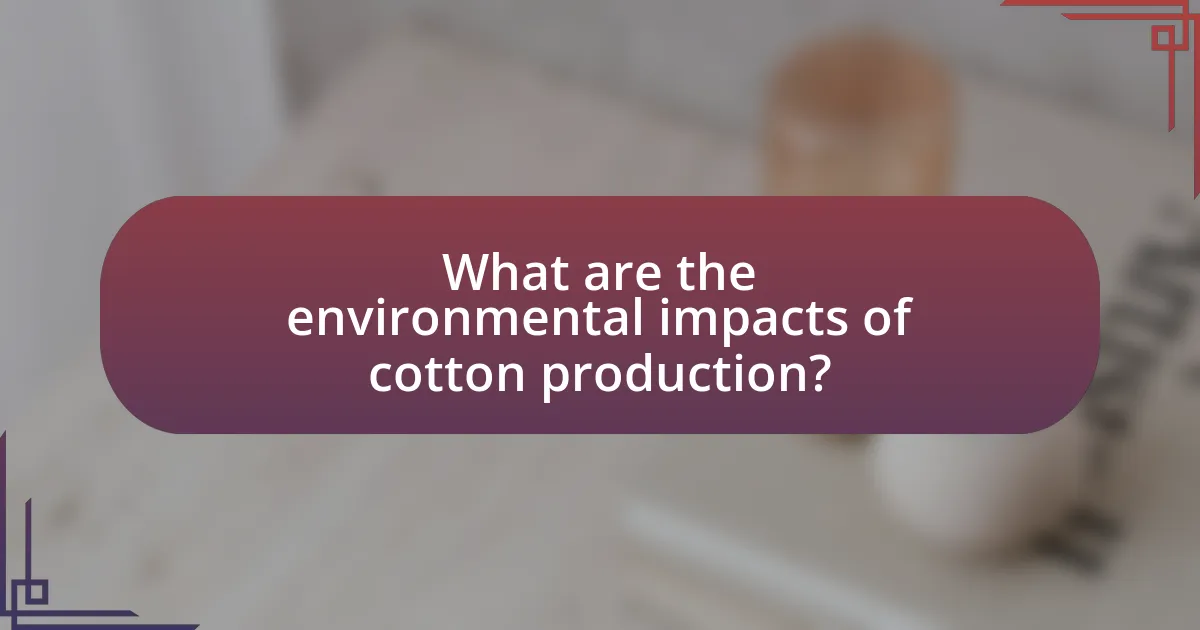
What are the environmental impacts of cotton production?
Cotton production has significant environmental impacts, primarily due to its high water consumption, pesticide use, and land degradation. The cultivation of cotton requires approximately 7,000 liters of water to produce just one kilogram of cotton, leading to water scarcity in regions where it is grown. Additionally, conventional cotton farming relies heavily on pesticides and fertilizers, with about 16% of global insecticides and 6% of global fertilizers used in cotton production, which can contaminate soil and water sources. Furthermore, the conversion of natural habitats into cotton fields contributes to biodiversity loss and soil erosion, exacerbating environmental degradation. These factors highlight the urgent need for sustainable practices in cotton production to mitigate its ecological footprint.
How does conventional cotton farming affect the environment?
Conventional cotton farming negatively impacts the environment primarily through high pesticide and fertilizer use, which leads to soil degradation and water pollution. The cultivation of cotton accounts for approximately 24% of global insecticide use and 11% of pesticides, contributing to biodiversity loss and harming aquatic ecosystems. Additionally, conventional cotton farming consumes significant amounts of water, with estimates suggesting that it takes about 7,000 liters of water to produce just one kilogram of cotton, exacerbating water scarcity issues in many regions. These practices not only threaten local wildlife but also contribute to broader environmental challenges, such as climate change and soil erosion.
What are the water usage concerns associated with cotton production?
Cotton production is associated with significant water usage concerns due to its high irrigation requirements. On average, it takes about 7,000 to 29,000 liters of water to produce one kilogram of cotton, depending on the region and agricultural practices. This extensive water consumption can lead to depletion of local water resources, negatively impacting ecosystems and communities reliant on those water supplies. Additionally, in areas where cotton is grown in arid climates, such as parts of Central Asia, the over-extraction of water for cotton farming has contributed to severe environmental issues, including the shrinking of the Aral Sea.
How do pesticides and chemicals impact ecosystems in cotton farming?
Pesticides and chemicals significantly disrupt ecosystems in cotton farming by harming biodiversity and contaminating soil and water sources. The application of these substances can lead to the decline of non-target species, including beneficial insects, birds, and aquatic life, which are essential for maintaining ecological balance. For instance, studies have shown that neonicotinoids, a class of pesticides, are linked to the decline of pollinator populations, crucial for crop production and ecosystem health. Additionally, runoff from cotton fields treated with chemicals can contaminate nearby water bodies, affecting aquatic ecosystems and drinking water quality. This disruption not only threatens wildlife but also undermines the sustainability of agricultural practices, making it imperative for consumers to consider the environmental impact when choosing cotton products.
What benefits does sustainable cotton offer to the environment?
Sustainable cotton offers significant environmental benefits, including reduced water usage, lower pesticide application, and improved soil health. Specifically, sustainable cotton farming practices can use up to 90% less water compared to conventional methods, as reported by the Better Cotton Initiative. Additionally, sustainable cotton reduces the reliance on harmful chemicals, with organic cotton farming using natural pest control methods, which helps preserve biodiversity. Furthermore, sustainable practices enhance soil quality through crop rotation and organic fertilizers, leading to healthier ecosystems.
How does sustainable cotton farming reduce environmental harm?
Sustainable cotton farming reduces environmental harm by employing practices that minimize pesticide use, conserve water, and enhance soil health. These methods include organic farming techniques, which eliminate synthetic chemicals, thereby protecting biodiversity and reducing pollution. For instance, according to the Textile Exchange’s 2021 report, organic cotton farming uses 91% less water compared to conventional methods, significantly lowering the strain on freshwater resources. Additionally, sustainable practices such as crop rotation and cover cropping improve soil fertility and structure, leading to healthier ecosystems.
What are the long-term benefits of choosing sustainable cotton for the planet?
Choosing sustainable cotton provides significant long-term benefits for the planet, including reduced environmental impact and enhanced biodiversity. Sustainable cotton farming practices minimize the use of harmful pesticides and fertilizers, leading to healthier soil and water systems. For instance, organic cotton farming uses 91% less water compared to conventional methods, as reported by the Textile Exchange. Additionally, sustainable practices promote crop rotation and polyculture, which support diverse ecosystems and improve resilience against pests and diseases. This approach not only conserves natural resources but also helps mitigate climate change by sequestering carbon in the soil. Overall, the adoption of sustainable cotton contributes to a healthier planet and supports sustainable agricultural practices.
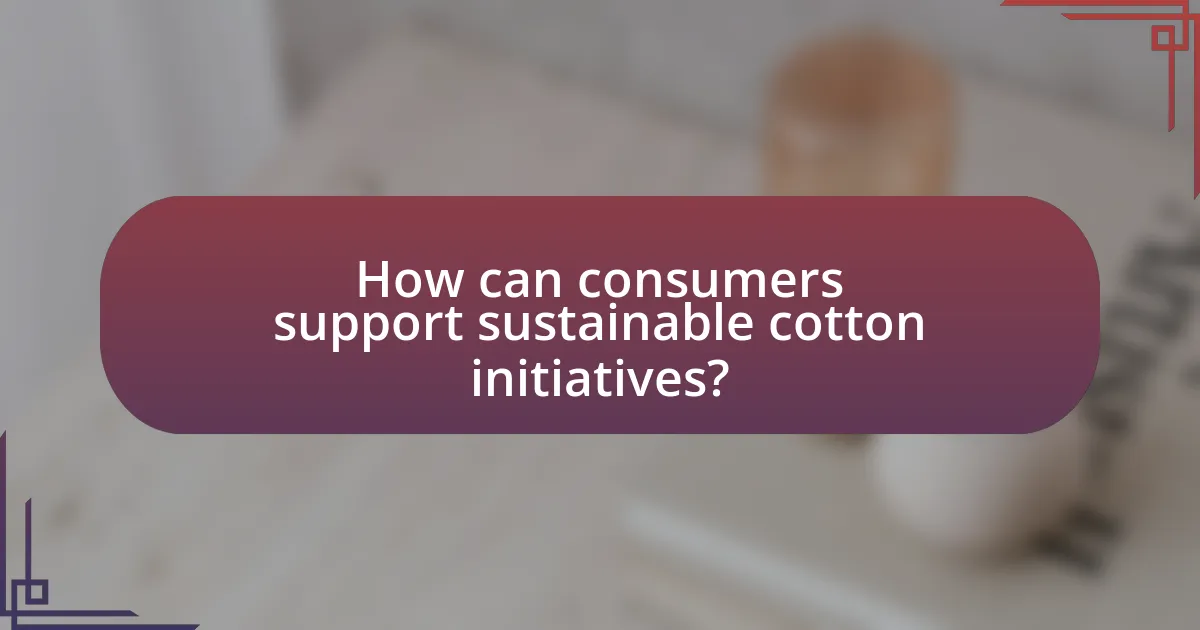
How can consumers support sustainable cotton initiatives?
Consumers can support sustainable cotton initiatives by choosing products made from certified organic or sustainably sourced cotton. By purchasing items labeled with certifications such as Global Organic Textile Standard (GOTS) or Better Cotton Initiative (BCI), consumers ensure that their choices promote environmentally friendly farming practices and fair labor conditions. Research indicates that organic cotton farming uses 91% less water and avoids harmful pesticides, making it a more sustainable option compared to conventional cotton.
What role do consumers play in promoting sustainable cotton practices?
Consumers play a crucial role in promoting sustainable cotton practices by driving demand for eco-friendly products. When consumers prioritize purchasing sustainably sourced cotton, they incentivize brands to adopt environmentally responsible practices, such as organic farming and reduced pesticide use. According to a 2021 report by the Textile Exchange, the global market for organic cotton reached 1.5 million metric tons, indicating a growing consumer preference for sustainable options. This shift not only encourages manufacturers to invest in sustainable practices but also raises awareness about the environmental impact of conventional cotton production, ultimately fostering a more sustainable industry.
How can consumers engage with brands to encourage sustainability?
Consumers can engage with brands to encourage sustainability by actively participating in feedback and dialogue regarding sustainable practices. By voicing preferences for eco-friendly products and supporting brands that prioritize sustainability, consumers can influence corporate behavior. For instance, a survey by Nielsen found that 66% of global consumers are willing to pay more for sustainable brands, demonstrating that consumer demand can drive companies to adopt greener practices. Additionally, consumers can utilize social media platforms to promote sustainable brands and share their experiences, further amplifying the message of sustainability in the marketplace.
What community initiatives support sustainable cotton production?
Community initiatives that support sustainable cotton production include programs like the Better Cotton Initiative (BCI), which promotes sustainable farming practices among cotton farmers globally. BCI works with farmers to reduce pesticide use, improve water management, and enhance soil health, thereby fostering environmentally friendly cotton production. Additionally, local cooperatives often engage in education and training for farmers on sustainable practices, helping to increase awareness and adoption of eco-friendly methods. These initiatives are crucial as they contribute to the overall sustainability of the cotton industry, ensuring that production meets environmental standards while supporting local economies.
What are some best practices for purchasing sustainable cotton products?
To purchase sustainable cotton products, consumers should prioritize certifications such as Global Organic Textile Standard (GOTS) and OEKO-TEX, which ensure environmentally friendly practices and safe materials. These certifications indicate that the cotton is grown without harmful pesticides and that the production process adheres to strict environmental and social criteria. Additionally, consumers should research brands that are transparent about their supply chains and sustainability practices, as companies committed to sustainability often provide detailed information about their sourcing and manufacturing processes. According to a 2021 report by the Textile Exchange, organic cotton production has increased by 56% over the past five years, highlighting a growing market for sustainable options.
How can consumers create a sustainable cotton shopping list?
Consumers can create a sustainable cotton shopping list by prioritizing organic cotton products, which are grown without harmful pesticides and synthetic fertilizers. Research indicates that organic cotton farming uses 91% less water than conventional methods, making it a more environmentally friendly choice. Additionally, consumers should look for certifications such as Global Organic Textile Standard (GOTS) or OEKO-TEX, which ensure that the cotton meets strict environmental and social criteria. By focusing on these factors, consumers can effectively contribute to sustainable cotton production and reduce their ecological footprint.
What tips can help consumers avoid unsustainable cotton products?
To avoid unsustainable cotton products, consumers should look for certifications such as Global Organic Textile Standard (GOTS) or OEKO-TEX, which indicate environmentally friendly practices. These certifications ensure that the cotton is grown without harmful pesticides and that the production process adheres to strict environmental and social criteria. Additionally, consumers can research brands that prioritize sustainable sourcing and transparency in their supply chains, as companies committed to sustainability often provide detailed information about their cotton sourcing practices. By choosing products from these certified brands, consumers can significantly reduce the likelihood of purchasing unsustainable cotton.
